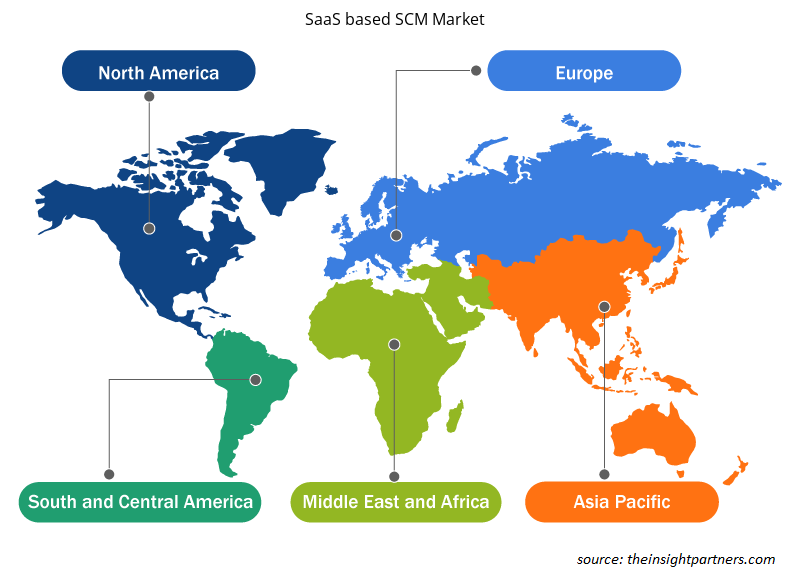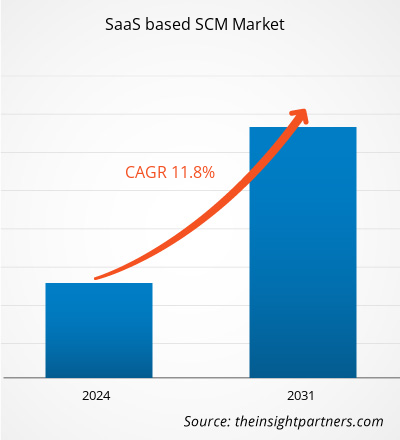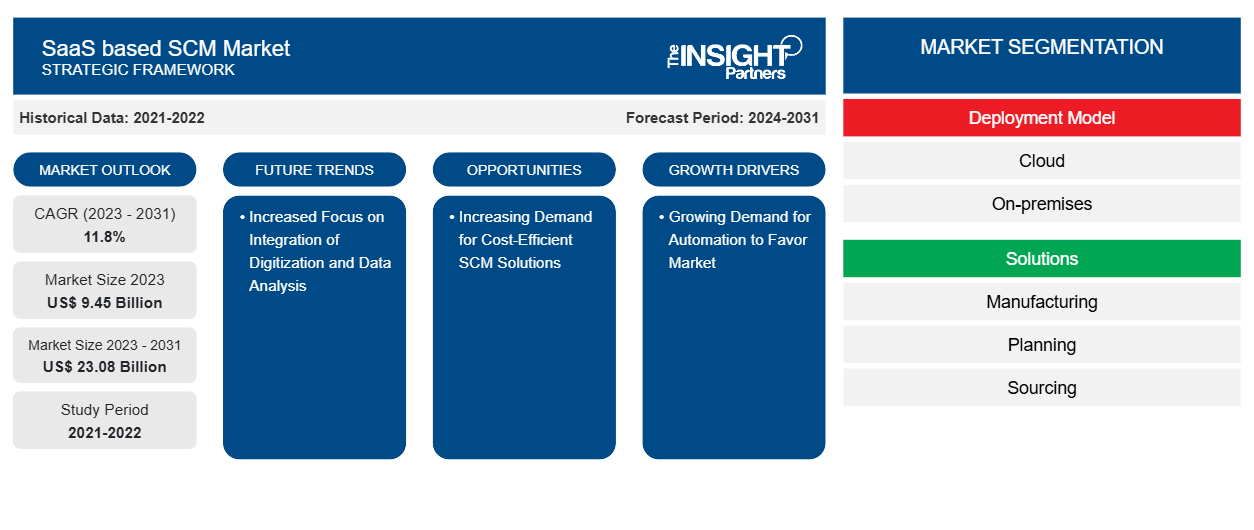من المتوقع أن يصل حجم سوق إدارة سلسلة التوريد القائمة على SaaS إلى 23.08 مليار دولار أمريكي بحلول عام 2031 من 9.45 مليار دولار أمريكي في عام 2023. ومن المتوقع أن يسجل السوق معدل نمو سنوي مركب بنسبة 11.8٪ في الفترة من 2023 إلى 2031. أصبح الطلب المتزايد على الأتمتة في إدارة سلسلة التوريد والحاجة المتزايدة إلى رؤية سلسلة التوريد أمرًا مهمًا بشكل متزايد.
تحليل سوق إدارة سلسلة التوريد القائمة على SaaS
من المتوقع أن ينمو سوق إدارة سلسلة التوريد القائمة على SaaS بوتيرة سريعة نتيجة للتقدم التكنولوجي، والحاجة المتزايدة إلى حلول إدارة سلسلة التوريد الفعالة والفعّالة من حيث التكلفة، والطلب المتزايد على الخدمات السحابية، أيضًا بسبب النمو في عدد الشركات الصغيرة والمتوسطة الحجم والحاجة إلى حلول إدارة سلسلة التوريد المتكاملة لرؤية سلسلة التوريد، وتحسين خدمة العملاء، وخفض التكلفة.
نظرة عامة على سوق إدارة سلسلة التوريد القائمة على SaaS
برنامج إدارة سلسلة التوريد SaaS (البرمجيات كخدمة) هو حل برمجي قائم على السحابة يساعد الشركات على إدارة سلسلة التوريد بأكملها. يعتبر برنامج إدارة سلسلة التوريد SaaS خيارًا شائعًا للشركات من جميع الأحجام لأنه سهل الاستخدام وقابل للتطوير وبأسعار معقولة مقارنة بالطرق التقليدية.
قم بتخصيص هذا التقرير ليناسب متطلباتك
ستحصل على تخصيص لأي تقرير - مجانًا - بما في ذلك أجزاء من هذا التقرير، أو تحليل على مستوى الدولة، وحزمة بيانات Excel، بالإضافة إلى الاستفادة من العروض والخصومات الرائعة للشركات الناشئة والجامعات
-
احصل على أهم اتجاهات السوق الرئيسية لهذا التقرير.ستتضمن هذه العينة المجانية تحليلاً للبيانات، بدءًا من اتجاهات السوق وحتى التقديرات والتوقعات.
محركات وفرص سوق إدارة سلسلة التوريد القائمة على SaaS
الطلب المتزايد على الأتمتة لصالح السوق
نظرًا لأن الأتمتة قد تقلل من العمل اليدوي وتعزز الكفاءة، فقد اكتسبت شعبية في صناعة إدارة سلسلة التوريد . يمكن للمؤسسات تعظيم عملياتها من خلال تقليل النفقات وزيادة الدقة من خلال الأتمتة. بالإضافة إلى ذلك، تسمح الأتمتة بإدارة عمليات سلسلة التوريد بمرونة وقابلية للتطوير، مما يساعد الشركات على التكيف بسرعة مع ظروف السوق المتغيرة وتوقعات العملاء.
تزايد الطلب على حلول إدارة سلسلة التوريد الفعالة من حيث التكلفة
من المتوقع أن تعمل الحاجة المتزايدة إلى حلول إدارة سلسلة التوريد المتكاملة على دفع نمو سوق إدارة سلسلة التوريد القائمة على SaaS خلال الفترة المتوقعة. المحرك الرئيسي للسوق هو الطلب المتزايد على أنظمة إدارة سلسلة التوريد التي تكون ميسورة التكلفة ومرنة وفعالة. هناك جانب مهم آخر يدفع توسع السوق وهو الحاجة المتزايدة إلى أنظمة إدارة سلسلة التوريد بأسعار معقولة. محرك رئيسي آخر للسوق هو الحاجة المتزايدة إلى حلول إدارة سلسلة التوريد الكاملة والمتكاملة. كما يتم دفع السوق أيضًا من خلال الطلب المتزايد على التقنيات والخدمات المستندة إلى السحابة، والتي من المتوقع أن تخفض تكاليف إدارة سلسلة التوريد وتسهل العمليات الأكثر فعالية.
تحليل تجزئة تقرير سوق إدارة سلسلة التوريد القائمة على SaaS
إن القطاعات الرئيسية التي ساهمت في اشتقاق تحليل سوق إدارة سلسلة التوريد القائمة على SaaS هي نموذج النشر والحلول والقطاع الرأسي والمستخدمين النهائيين.
- وفقًا لنموذج النشر، يتم تقسيم سوق إدارة سلسلة التوريد المستندة إلى SaaS إلى السحابة والمحلية.
- من حيث الحلول، يتم تقسيم السوق إلى التصنيع والتخطيط، والتوريد والشراء، وتخطيط سلسلة التوريد، وإدارة المستودعات ، وإدارة النقل، وغيرها.
- بناءً على الصناعة العمودية،ينقسم سوق إدارة سلسلة التوريد المستندة إلى SaaS إلى خدمات النقل والخدمات اللوجستية، والتصنيع، والتجزئة، والقطاع العام، وشبكة التوزيع.SCM market is divided into transport and logistics service, manufacturing, retail, public sector, and distribution network.
- من حيث المستخدمين النهائيين، ينقسم السوق إلى الشركات الصغيرة والمتوسطة والشركات الكبيرة.
تحليل حصة سوق إدارة سلسلة التوريد القائمة على SaaS حسب المنطقة الجغرافيةSCM Market Share Analysis by Geography
ينقسم النطاق الجغرافي لتقرير سوق إدارة سلسلة التوريد القائمة على SaaS بشكل أساسي إلى خمس مناطق: أمريكا الشمالية، ومنطقة آسيا والمحيط الهادئ، وأوروبا، والشرق الأوسط وأفريقيا، وأمريكا الجنوبية/أمريكا الجنوبية والوسطى. سيطرت أمريكا الشمالية على سوق إدارة سلسلة التوريد القائمة على SaaS. وقد أدت اتجاهات تبني التكنولوجيا العالية في مختلف الصناعات في منطقة أمريكا الشمالية إلى تغذية نمو سوق إدارة سلسلة التوريد القائمة على SaaS. ومن المتوقع أن تؤدي عوامل مثل زيادة تبني التكنولوجيا الرقمية والإنفاق التكنولوجي العالي من قبل الوكالات الحكومية إلى دفع نمو سوق إدارة سلسلة التوريد القائمة على SaaS في أمريكا الشمالية. علاوة على ذلك، فإن التركيز القوي على البحث والتطوير في الاقتصادات المتقدمة في الولايات المتحدة وكندا يجبر اللاعبين في أمريكا الشمالية على جلب حلول متقدمة تقنيًا إلى السوق. بالإضافة إلى ذلك، يوجد في الولايات المتحدة عدد كبير من اللاعبين في سوق إدارة سلسلة التوريد القائمة على SaaS والذين يركزون بشكل متزايد على تطوير حلول مبتكرة. تساهم كل هذه العوامل في نمو سوق إدارة سلسلة التوريد القائمة على SaaS في المنطقة.
رؤى إقليمية حول سوق إدارة سلسلة التوريد القائمة على SaaS
لقد قام المحللون في Insight Partners بشرح الاتجاهات والعوامل الإقليمية المؤثرة على سوق إدارة سلسلة التوريد القائمة على SaaS طوال فترة التنبؤ بشكل شامل. يناقش هذا القسم أيضًا قطاعات سوق إدارة سلسلة التوريد القائمة على SaaS والجغرافيا في جميع أنحاء أمريكا الشمالية وأوروبا ومنطقة آسيا والمحيط الهادئ والشرق الأوسط وأفريقيا وأمريكا الجنوبية والوسطى.

- احصل على البيانات الإقليمية المحددة لسوق إدارة سلسلة التوريد القائمة على SaaS
نطاق تقرير سوق إدارة سلسلة التوريد القائمة على SaaS
| سمة التقرير | تفاصيل |
|---|---|
| حجم السوق في عام 2023 | 9.45 مليار دولار أمريكي |
| حجم السوق بحلول عام 2031 | 23.08 مليار دولار أمريكي |
| معدل النمو السنوي المركب العالمي (2023 - 2031) | 11.8% |
| البيانات التاريخية | 2021-2022 |
| فترة التنبؤ | 2024-2031 |
| القطاعات المغطاة |
حسب نموذج النشر
|
| المناطق والدول المغطاة |
أمريكا الشمالية
|
| قادة السوق وملفات تعريف الشركات الرئيسية |
|
كثافة اللاعبين في سوق إدارة سلسلة التوريد القائمة على SaaS: فهم تأثيرها على ديناميكيات الأعمال
يشهد سوق إدارة سلسلة التوريد القائمة على SaaS نموًا سريعًا، مدفوعًا بالطلب المتزايد من المستخدم النهائي بسبب عوامل مثل تفضيلات المستهلك المتطورة والتقدم التكنولوجي والوعي المتزايد بفوائد المنتج. ومع ارتفاع الطلب، تعمل الشركات على توسيع عروضها والابتكار لتلبية احتياجات المستهلكين والاستفادة من الاتجاهات الناشئة، مما يؤدي إلى زيادة نمو السوق.
تشير كثافة اللاعبين في السوق إلى توزيع الشركات أو المؤسسات العاملة في سوق أو صناعة معينة. وهي تشير إلى عدد المنافسين (اللاعبين في السوق) الموجودين في مساحة سوق معينة نسبة إلى حجمها أو قيمتها السوقية الإجمالية.
الشركات الرئيسية العاملة في سوق SCM المستندة إلى SaaS هي:
- مجموعة أنظمة ديكارت
- معلومات
- كليو
- ساب
- شركة إبيكور للبرمجيات
- أوراكل
إخلاء المسؤولية : الشركات المذكورة أعلاه ليست مرتبة بأي ترتيب معين.

- احصل على نظرة عامة على أهم اللاعبين الرئيسيين في سوق إدارة سلسلة التوريد القائمة على SaaS
أخبار سوق إدارة سلسلة التوريد القائمة على SaaS والتطورات الأخيرة
يتم تقييم سوق إدارة سلسلة التوريد القائمة على SaaS من خلال جمع البيانات النوعية والكمية بعد البحث الأولي والثانوي، والذي يتضمن منشورات الشركات المهمة وبيانات الجمعيات وقواعد البيانات. فيما يلي قائمة بالتطورات في السوق:
- في أبريل 2023، - تواصل Inspectorio، الحل الرائد لـ SaaS المدعوم بالذكاء الاصطناعي لمنظمات سلسلة التوريد، كسر الحواجز في صناعة سلسلة التوريد من خلال تقديم Inspectorio CAPA recommender، أول أداة ذكاء اصطناعي توليدية مدفوعة بـ ChatGPT في العالم لمساعدة العلامات التجارية وتجار التجزئة والموردين والمصانع وغيرهم في إدارة سلسلة التوريد.
(المصدر: Inspectorio، بيان صحفي، 2023)
- في فبراير 2023، أعلنت شركة Zscaler، Inc.، إحدى الشركات الرائدة في مجال أمن السحابة، عن نيتها الاستحواذ على شركة Canonic Security، وهي شركة مبتكرة لمنصة أمان تطبيقات SaaS. صُممت منصة Canonic لمنع المخاطر المتزايدة التي تتعرض لها المؤسسات من هجمات سلسلة توريد SaaS. ومع الهجرة الهائلة إلى السحابة، حيث تتبنى المؤسسات مئات منصات SaaS، يقوم مستخدموها بربط آلاف التطبيقات الخارجية وملحقات المتصفح بمنصات SaaS المهمة مثل Atlassian Suite وMicrosoft 365 وSalesforce وGoogle Workspace وSlack دون إذن من قسم تكنولوجيا المعلومات.
(المصدر: Zscaler, Inc.، بيان صحفي، 2023)
تقرير سوق إدارة سلسلة التوريد القائمة على SaaS والتغطية والنتائج النهائية
يوفر تقرير "حجم سوق إدارة سلسلة التوريد القائمة على SaaS والتوقعات (2021-2031)" تحليلاً مفصلاً للسوق يغطي المجالات التالية:
- حجم السوق والتوقعات على المستويات العالمية والإقليمية والوطنية لجميع قطاعات السوق الرئيسية التي يغطيها النطاق
- ديناميكيات السوق مثل المحركات والقيود والفرص الرئيسية
- الاتجاهات المستقبلية الرئيسية
- تحليل مفصل لقوى PEST/Porter الخمس وSWOT
- تحليل السوق العالمي والإقليمي الذي يغطي اتجاهات السوق الرئيسية واللاعبين الرئيسيين واللوائح والتطورات الأخيرة في السوق
- تحليل المشهد الصناعي والمنافسة الذي يغطي تركيز السوق، وتحليل خريطة الحرارة، واللاعبين البارزين، والتطورات الأخيرة
- ملفات تعريف الشركة التفصيلية
- التحليل التاريخي (سنتان)، سنة الأساس، التوقعات (7 سنوات) مع معدل النمو السنوي المركب
- تحليل PEST و SWOT
- حجم السوق والقيمة / الحجم - عالمي، إقليمي، بلد
- الصناعة والمنافسة
- مجموعة بيانات إكسل
التقارير الحديثة
شهادات العملاء
سبب الشراء
- اتخاذ قرارات مدروسة
- فهم ديناميكيات السوق
- تحليل المنافسة
- رؤى العملاء
- توقعات السوق
- تخفيف المخاطر
- التخطيط الاستراتيجي
- مبررات الاستثمار
- تحديد الأسواق الناشئة
- تحسين استراتيجيات التسويق
- تعزيز الكفاءة التشغيلية
- مواكبة التوجهات التنظيمية























 احصل على عينة مجانية ل - سوق إدارة سلسلة التوريد القائمة على SaaS
احصل على عينة مجانية ل - سوق إدارة سلسلة التوريد القائمة على SaaS